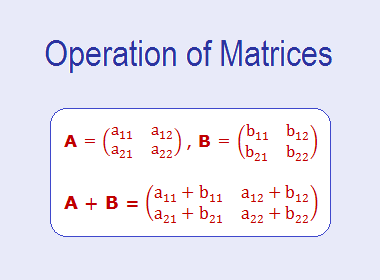
Operation of Matrices
Here in Operation of Matrices, we deal with the Addition of Matrices, Subtraction
of Matrices and Multiplication of a Matrix
by a scalar (real number).
********************
10 Math Problems officially announces the release of Quick Math Solver and 10 Math Problems, Apps on Google Play Store for students around the world.
********************
********************
Addition of Matrices
If A and B are two matrices of the same order, then A and B are said to be Conformable or Compatible for addition. The sum of A and B is denoted by A + B and it is obtained by adding corresponding elements of matrices A and B.
The matrix A + B will be of the same
order as each of the matrices A and B is.
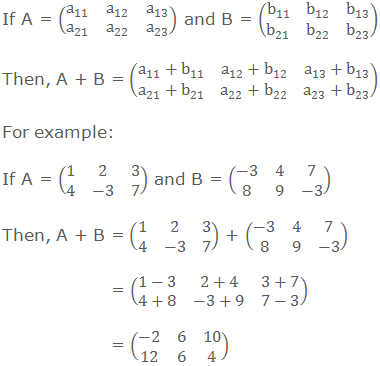
Subtraction of Matrices
If A and B are two matrices of the same order,
then they are said to be conformable for subtraction. The difference of the
matrix B from A is denoted by A – B and it is obtained by subtracting the
elements of B from the corresponding elements of A.
The order of the matrix A – B is same as the order
of A or B.
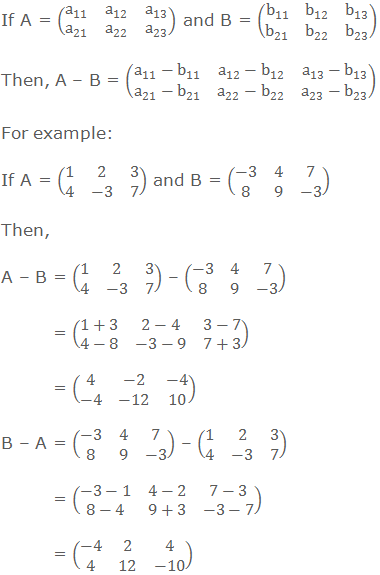
Multiplication of a Matrix by a scalar (real number)
If A is any matrix and k is any constant or a
scalar, then the matrix obtained by multiplying each element of A by k is
denoted by kA and it is called scalar multiple of A by k.
The order of the matrix kA is the same as the order of
the matrix A.

Algebraic Properties of Matrix Addition
The addition of matrices satisfies the following
properties:
1. Closure property:
If A and B are two matrices
of the same order, then their sum A + B is also a matrix of the same order as
that of A or B.

2. Commutative property:
If A and B are two matrices
of the same order, then A + B = B + A.
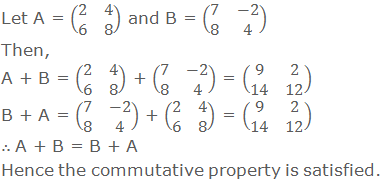
3. Associative properties:
If A, B and C are three matrices
of the same order, then (A + B) + C = A + (B + C)
![Associative property Let A = (■(1&2@3&4)), B = (■(5&6@7&8)) and C = (■(9&10@11&12)) Then, (A + B) + C = [(■(1&2@3&4)) + (■(5&6@7&8)) ] + (■(9&10@11&12)) = (■(6&8@10&12)) + (■(9&10@11&12)) = (■(15&18@21&24)) A + (B + C) = (■(1&2@3&4)) + [(■(5&6@7&8))+ (■(9&10@11&12)) ] = (■(1&2@3&4)) + (■(14&16@18&20)) = (■(15&18@21&24)) ∴ (A + B) + C = A + (B + C) Hence the associative property is satisfied.](https://blogger.googleusercontent.com/img/b/R29vZ2xl/AVvXsEhWUF2WErH4Tl4fZnOKfGNYg4jS6EXfzr-xPw3VZCDSU9VjDC6_kZMXw6mi6-DeoSK-HYArE2xZX7uL5fWFXLZg-xk7aH8HS_G_4YstBM5OqJ5_e54GrgklnILUy872Xg9_EkDdsYZiwT97/s16000/associative+property.png)
4. Existence of additive identity:
If A is any matrix, then
there exists a null matrix O of the same order such as A + O = O + A = A.
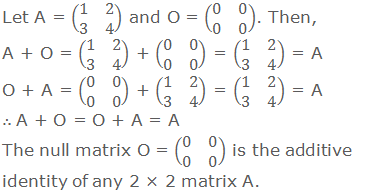
5. Existence of additive
inverse:
If A is a matrix of any
order, then there exists another matrix –A or same order such that A + (-A) =
(-A) + A = O, the additive identity.
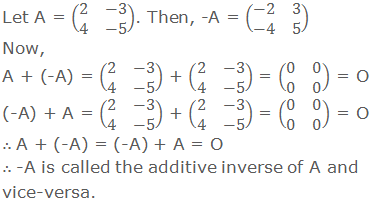
6. If A and B are the matrices
of the same order and k is a scalar, then k(A + B) = kA + kB.
![k(A + B) = kA + kB Let A = (■(3&-7@8&4)), B = (■(-4&6@-2&8)) and k = 2 Then, k(A + B) = 2[(■(3&-7@8&4)) + (■(-4&6@-2&8)) ] = 2(■(-1&-1@6&12)) = (■(-2&-2@12&24)) kA + kB = 2(■(3&-7@8&4)) + 2(■(-4&6@-2&8)) = (■(6&-14@16&8)) + (■(-8&12@-4&16)) = (■(-2&-2@12&24)) ∴ k(A + B) = kA + kB.](https://blogger.googleusercontent.com/img/b/R29vZ2xl/AVvXsEh4_GRvY6FAYUCVQVSmsb98WVcVrGLwJ82kGbzdl2-VJmlyLyk8_gMKp8by7WpSfg4T7OFQ7UAckxC2qikiSNI7Wxdf7LdhHtw9IjQWIl-xfqDaS7U4bZ-adPIMk9Ortxo5PHIAwU92woEk/s16000/k%2528A+%252B+B%2529+%253D+kA+%252B+kB.png)
7. If A is a matrix and c, k
are any two scalars, then (c + k)A = cA + kA.
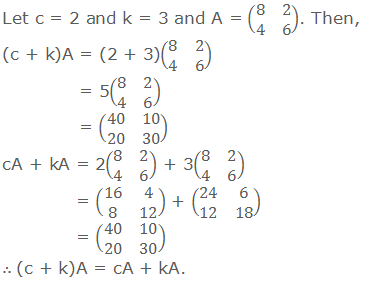
8. If c, k are any two scalars
and A is a matrix, then c(kA) = (ck)A.
![c(kA) = (ck)A Let c = -2 and k = 4 and A = (■(4&5@-3&7)). Then, c(kA) = -2[4(■(4&5@-3&7)) ] = -2(■(16&20@-12&28)) = (■(-32&-40@24&-56)) (ck)A = (-2×4)(■(4&5@-3&7)) = -8(■(4&5@-3&7)) = (■(-32&-40@24&-56)) ∴ c(kA) = (ck)A.](https://blogger.googleusercontent.com/img/b/R29vZ2xl/AVvXsEjwaeL3dv0Ri9HjIWv8iYw_Ik49f32xNQc7iNQcb2UVOwobRQFdn9TqZWGFV5wwDYkh6U0MYkHUJDLxzvlnpy8shJbxhmD5GJfp9Yonj2acGy-m60wQIWp9BiXoDeX1Orij3aTU2K0LtqYG/s16000/c%2528kA%2529+%253D+%2528ck%2529A.png)
Worked Out Examples

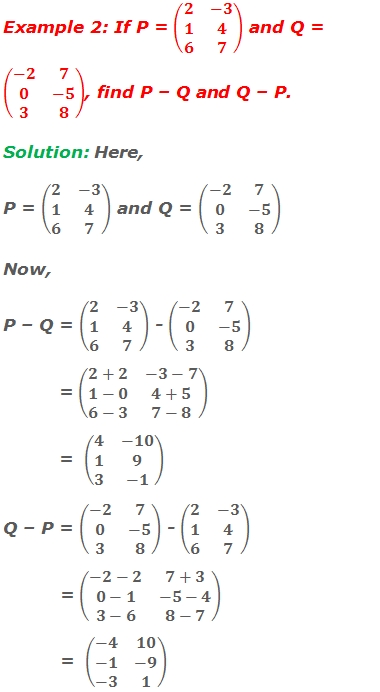
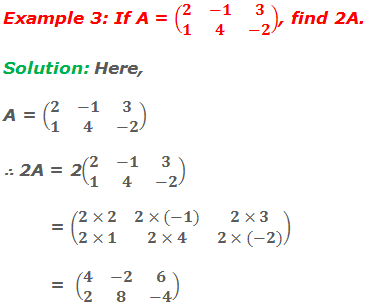
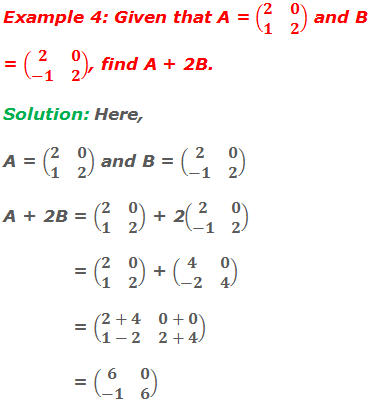
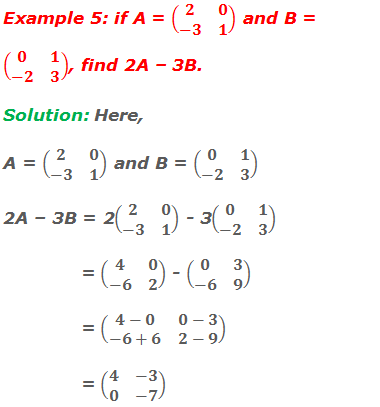
Do you have any questions regarding the enlargement and reduction?
You can ask your questions or problems here, in the comment section below.



0 comments: